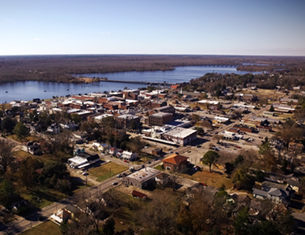TITAN vs. TITAN: President Trump and the Federal Courts Face Off Over His Temporary Travel Ban
Section 1021 of the NDAA reads:
SEC. 1021. AFFIRMATION OF AUTHORITY OF THE ARMED FORCES OF THE UNITED STATES TO DETAIN COVERED PERSONS PURSUANT TO THE AUTHORIZATION FOR USE OF MILITARY FORCE.
(a) In General- Congress affirms that the authority of the President to use all necessary and appropriate force pursuant to the Authorization for Use of Military Force (Public Law 107-40; 50 U.S.C. 1541 note) includes the authority for the Armed Forces of the United States to detain covered persons (as defined in subsection (b)) pending disposition under the law of war.
(b) Covered Persons- A covered person under this section is any person as follows:
(1) A person who planned, authorized, committed, or aided the terrorist attacks that occurred on September 11, 2001, or harbored those responsible for those attacks.
(2) A person who was a part of or substantially supported al-Qaeda, the Taliban, or associated forces that are engaged in hostilities against the United States or its coalition partners, including any person who has committed a belligerent act or has directly supported such hostilities in aid of such enemy forces.
(c) Disposition Under Law of War- The disposition of a person under the law of war as described in subsection (a) may include the following:
(1) Detention under the law of war without trial until the end of the hostilities authorized by the Authorization for Use of Military Force.
(2) Trial under chapter 47A of title 10, United States Code (as amended by the Military Commissions Act of 2009 (title XVIII of Public Law 111-84)).
(3) Transfer for trial by an alternative court or competent tribunal having lawful jurisdiction.
(4) Transfer to the custody or control of the person's country of origin, any other foreign country, or any other foreign entity.
With the NDAA, which has been re-upped for fiscal year 2017, we see the president enlarging his war powers. We see that he acknowledges that the war on terror has already come to our homeland.
In 2014, ISIS (The Islamic State) was gaining power and President Obama lacked a strategy to deal with it. At the end of the year, House Speaker John Boehner advised: "I would urge the president to submit a new Authorization for Use of Military Force (AUMF) regarding our efforts to defeat and to destroy ISIL." In that demand, Boehner was echoing constitutional scholar and then-presidential hopeful, Senator Ted Cruz and strict constitutionalist Rand Paul. Senator Cruz asserted that "initiating new military hostilities in a sustained basis in Iraq obligates the president to go back to Congress and to make the case to seek congressional authorization" and Senator Rand Paul said, "I believe the President must come to Congress to begin a war and that Congress has a duty to act. Right now, this war is illegal until Congress acts pursuant to the Constitution and authorizes it." And so, in February 2015, President Obama asked Congress for that authorization. The US had already been bombing ISIS for six months. Ignoring the advice of Boehner, Cruz, and Paul, the White House claimed it already enjoyed the legal right to wage war under the 2001 AUMF and thus didn't need the new authorization. But still, the White House went ahead and asked. It's proposed AUMF would authorize force against ISIS, but only for three years. Congress never granted that AUMF, but it did go ahead and fund military actions.
Again, we note that the War on Terror is enlarging and in fact, as we learn from the events unfolding in the Middle East, the terrorist network is organizing, gaining power, and poised take over several regions. We see and that the United States is still very much determined to contain the growing evil that threatens the freedom and security of her citizens and of the world.
IV. The Korematsu v. United States decision (1944) -
The Korematsu case famously addresses the constitutionality of Japanese internment in the wake of the attack on Pearl Harbor by the empire of Japan. It addressed the war powers of Congress and the war powers of the President, as Commander-in-chief. The opinion, written by justice Hugo Black, held that the need to protect against espionage outweighed Fred Korematsu's individual rights, and the rights of Americans of Japanese descent, and that the validity of action under the war power must be judged wholly in the context of war. He argued that compulsory exclusion, though constitutionally suspect, is justified during circumstances of "emergency and peril."
The case upheld a law excluding certain Americans (American citizens, to be clear) from areas in the United States on account of national security. It found that although there was discrimination on account of nationality, which would subject that law to the most stringent of judicial scrutiny, the policy survived that scrutiny because national security required it.
We cannot forget that our country suffered an attack perhaps more horrific than Pearl Harbor on 9/11, as ordinary citizens were targeted in skyscrapers rather than military personnel. And although President Bush and his Homeland Security Department managed to keep us safe in our homeland during his two terms, President Obama and his Homeland Security team could not. In fact, as the world seemed to explode in Islamic attacks, so did our country. It seems quite clear to most people that terrorism is on the rise and that we need to ramp up both our offense and defense in this War on Terrorism.
The opinion of the Court, as delivered by Justice Hugo Black (appointed by FDR):
The petitioner, an American citizen of Japanese descent, was convicted in a federal district court for remaining in San Leandro, California, a "Military Area," contrary to Civilian Exclusion Order No. 34 of the Commanding General of the Western Command, U.S. Army, which directed that, after May 9, 1942, all persons of Japanese ancestry should be excluded from that area. No question was raised as to petitioner's loyalty to the United States. The Circuit Court of Appeals affirmed, and the importance of the constitutional question involved caused us to grant certiorari.
It should be noted, to begin with, that all legal restrictions which curtail the civil rights of a single racial group are immediately suspect. That is not to say that all such restrictions are unconstitutional. It is to say that courts must subject them to the most rigid scrutiny. Pressing public necessity may sometimes justify the existence of such restrictions; racial antagonism never can.
In the instant case, prosecution of the petitioner was begun by information charging violation of an Act of Congress, of March 21, 1942, 56 Stat. 173, which provides that:
.....whoever shall enter, remain in, leave, or commit any act in any military area or military zone prescribed, under the authority of an Executive order of the President, by the Secretary of War, or by any military commander designated by the Secretary of War, contrary to the restrictions applicable to any such area or zone or contrary to the order of the Secretary of War or any such military commander, shall, if it appears that he knew or should have known of the existence and extent of the restrictions or order and that his act was in violation thereof, be guilty of a misdemeanor and upon conviction shall be liable to a fine of not to exceed $5,000 or to imprisonment for not more than one year, or both, for each offense.
Exclusion Order No. 34, which the petitioner knowingly and admittedly violated, was one of a number of military orders and proclamations, all of which were substantially based upon Executive Order No. 9066, 7 Fed.Reg. 1407. That order, issued after we were at war with Japan, declared that "the successful prosecution of the war requires every possible protection against espionage and against sabotage to national defense material, national defense premises, and national defense utilities...."
One of the series of orders and proclamations, a curfew order, which, like the exclusion order here, was promulgated pursuant to Executive Order 9066, subjected all persons of Japanese ancestry in prescribed West Coast military areas to remain in their residences from 8 p.m. to 6 a.m. As is the case with the exclusion order here, that prior curfew order was designed as a "protection against espionage and against sabotage." In Hirabayashi v. United States, 320 U.S. 81 (1943), we sustained a conviction obtained for violation of the curfew order. The Hirabayashi conviction and this one thus rest on the same 1942 Congressional Act and the same basic executive and military orders, all of which orders were aimed at the twin dangers of espionage and sabotage.
The 1942 Act was attacked in the Hirabayashi case as an unconstitutional delegation of power; it was contended that the curfew order and other orders on which it rested were beyond the war powers of the Congress, the military authorities, and of the President, as Commander in Chief of the Army, and, finally, that to apply the curfew order against none but citizens of Japanese ancestry amounted to a constitutionally prohibited discrimination solely on account of race. To these questions, we gave the serious consideration which their importance justified. We upheld the curfew order as an exercise of the power of the government to take steps necessary to prevent espionage and sabotage in an area threatened by Japanese attack.
In the light of the principles, we announced in the Hirabayashi case, we are unable to conclude that it was beyond the war power of Congress and the Executive to exclude those of Japanese ancestry from the West Coast war area at the time they did. True, exclusion from the area in which one's home is located is a far greater deprivation than constant confinement to the home from 8 p.m. to 6 a.m. Nothing short of apprehension by the proper military authorities of the gravest imminent danger to the public safety can constitutionally justify either. But exclusion from a threatened area, no less than curfew, has a definite and close relationship to the prevention of espionage and sabotage. The military authorities, charged with the primary responsibility of defending our shores, concluded that curfew provided inadequate protection and ordered exclusion. They did so, as pointed out in our Hirabayashi opinion, in accordance with Congressional authority to the military to say who should, and who should not, remain in the threatened areas.
In this case, the petitioner challenges the assumptions upon which we rested our conclusions in the Hirabayashi case. He also urges that, by May, 1942, when Order No. 34 was promulgated, all danger of Japanese invasion of the West Coast had disappeared. After careful consideration of these contentions, we are compelled to reject them.
Here, as in the Hirabayashi case:
..... we cannot reject as unfounded the judgment of the military authorities and of Congress that there were disloyal members of that population, whose number and strength could not be precisely and quickly ascertained. We cannot say that the war-making branches of the Government did not have ground for believing that, in a critical hour, such persons could not readily be isolated and separately dealt with, and constituted a menace to the national defense and safety which demanded that prompt and adequate measures be taken to guard against it.
Like curfew, exclusion of those of Japanese origin was deemed necessary because of the presence of an unascertained number of disloyal members of the group, most of whom we have no doubt were loyal to this country. It was because we could not reject the finding of the military authorities that it was impossible to bring about an immediate segregation of the disloyal from the loyal that we sustained the validity of the curfew order as applying to the whole group. In the instant case, temporary exclusion of the entire group was rested by the military on the same ground. The judgment that exclusion of the whole group was, for the same reason, a military imperative answers the contention that the exclusion was in the nature of group punishment based on antagonism to those of Japanese origin. That there were members of the group who retained loyalties to Japan has been confirmed by investigations made subsequent to the exclusion. Approximately five thousand American citizens of Japanese ancestry refused to swear unqualified allegiance to the United States and to renounce allegiance to the Japanese Emperor, and several thousand evacuees requested repatriation to Japan.
We uphold the exclusion order as of the time it was made and when the petitioner violated it. In doing so, we are not unmindful of the hardships imposed by it upon a large group of American citizens. Hardships are part of war, and war is an aggregation of hardships. All citizens alike, both in and out of uniform, feel the impact of war in greater or lesser measure. Citizenship has its responsibilities, as well as its privileges, and, in time of war, the burden is always heavier. Compulsory exclusion of large groups of citizens from their homes, except under circumstances of direst emergency and peril, is inconsistent with our basic governmental institutions. But when, under conditions of modern warfare, our shores are threatened by hostile forces, the power to protect must be commensurate with the threatened danger.
It is argued that, on May 30, 1942, the date the petitioner was charged with remaining in the prohibited area, there were conflicting orders outstanding, forbidding him both to leave the area and to remain there. Of course, a person cannot be convicted for doing the very thing which it is a crime to fail to do. But the outstanding orders here contained no such contradictory commands.
There was an order issued March 27, 1942, which prohibited petitioner and others of Japanese ancestry from leaving the area, but its effect was specifically limited in time "until and to the extent that a future proclamation or order should so permit or direct." 7 Fed.Reg. 2601. That "future order," the one for violation of which petitioner was convicted, was issued May 3, 1942, and it did "direct" exclusion from the area of all persons of Japanese ancestry before 12 o'clock noon, May 9; furthermore, it contained a warning that all such persons found in the prohibited area would be liable to punishment under the March 21, 1942, Act of Congress. Consequently, the only order in effect touching the petitioner's being in the area on May 30, 1942, the date specified in the information against him, was the May 3 order which prohibited his remaining there, and it was that same order which he stipulated in his trial that he had violated, knowing of its existence. There is therefore no basis for the argument that, on May 30, 1942, he was subject to punishment, under the March 27 and May 3 orders, whether he remained in or left the area.
It does appear, however, that, on May 9, the effective date of the exclusion order, the military authorities had already determined that the evacuation should be effected by assembling together and placing under guard all those of Japanese ancestry at central points, designated as "assembly centers," in order to insure the orderly evacuation and resettlement of Japanese voluntarily migrating from Military Area No. 1, to restrict and regulate such migration.
Public Proclamation No. 4, 7 Fed.Reg. 2601. And on May 19, 1942, eleven days before the time petitioner was charged with unlawfully remaining in the area, Civilian Restrictive Order No. 1, 8 Fed.Reg. 982, provided for detention of those of Japanese ancestry in assembly or relocation centers. It is now argued that the validity of the exclusion order cannot be considered apart from the orders requiring him, after departure from the area, to report and to remain in an assembly or relocation center. The contention is that we must treat these separate orders as one and inseparable; that, for this reason, if detention in the assembly or relocation center would have illegally deprived the petitioner of his liberty, the exclusion order and his conviction under it cannot stand.
We are thus being asked to pass at this time upon the whole subsequent detention program in both assembly and relocation centers, although the only issues framed at the trial related to petitioner's remaining in the prohibited area in violation of the exclusion order. Had petitioner here left the prohibited area and gone to an assembly center, we cannot say, either as a matter of fact or law, that his presence in that center would have resulted in his detention in a relocation center. Some who did report to the assembly center were not sent to relocation centers, but were released upon condition that they remain outside the prohibited zone until the military orders were modified or lifted. This illustrates that they pose different problems, and may be governed by different principles. The lawfulness of one does not necessarily determine the lawfulness of the others. This is made clear when we analyze the requirements of the separate provisions of the separate orders. These separate requirements were that those of Japanese ancestry (1) depart from the area; (2) report to and temporarily remain in an assembly center; (3) go under military control to a relocation center, there to remain for an indeterminate period until released conditionally or unconditionally by the military authorities. Each of these requirements, it will be noted, imposed distinct duties in connection with the separate steps in a complete evacuation program. Had Congress directly incorporated into one Act the language of these separate orders, and provided sanctions for their violations, disobedience of any one would have constituted a separate offense. There is no reason why violations of these orders, insofar as they were promulgated pursuant to Congressional enactment, should not be treated as separate offenses.
Some of the members of the Court are of the view that evacuation and detention in an Assembly Center were inseparable. After May 3, 1942, the date of Exclusion Order No. 34, Korematsu was under compulsion to leave the area not as he would choose, but via an Assembly Center. The Assembly Center was conceived as a part of the machinery for group evacuation. The power to exclude includes the power to do it by force if necessary. And any forcible measure must necessarily entail some degree of detention or restraint, whatever method of removal is selected. But whichever view is taken, it results in holding that the order under which petitioner was convicted was valid.
Go Back
























This may be unprecedented territory, as our protections have now been allocated, in some small measure, to the state of Washington.
Liberals are funny when they try to govern, or adjudicate, and what is really humorous is how they rally around one another as if they have some great wisdom that is beyond the rest of us, and the Constitution the provides our nation structure.